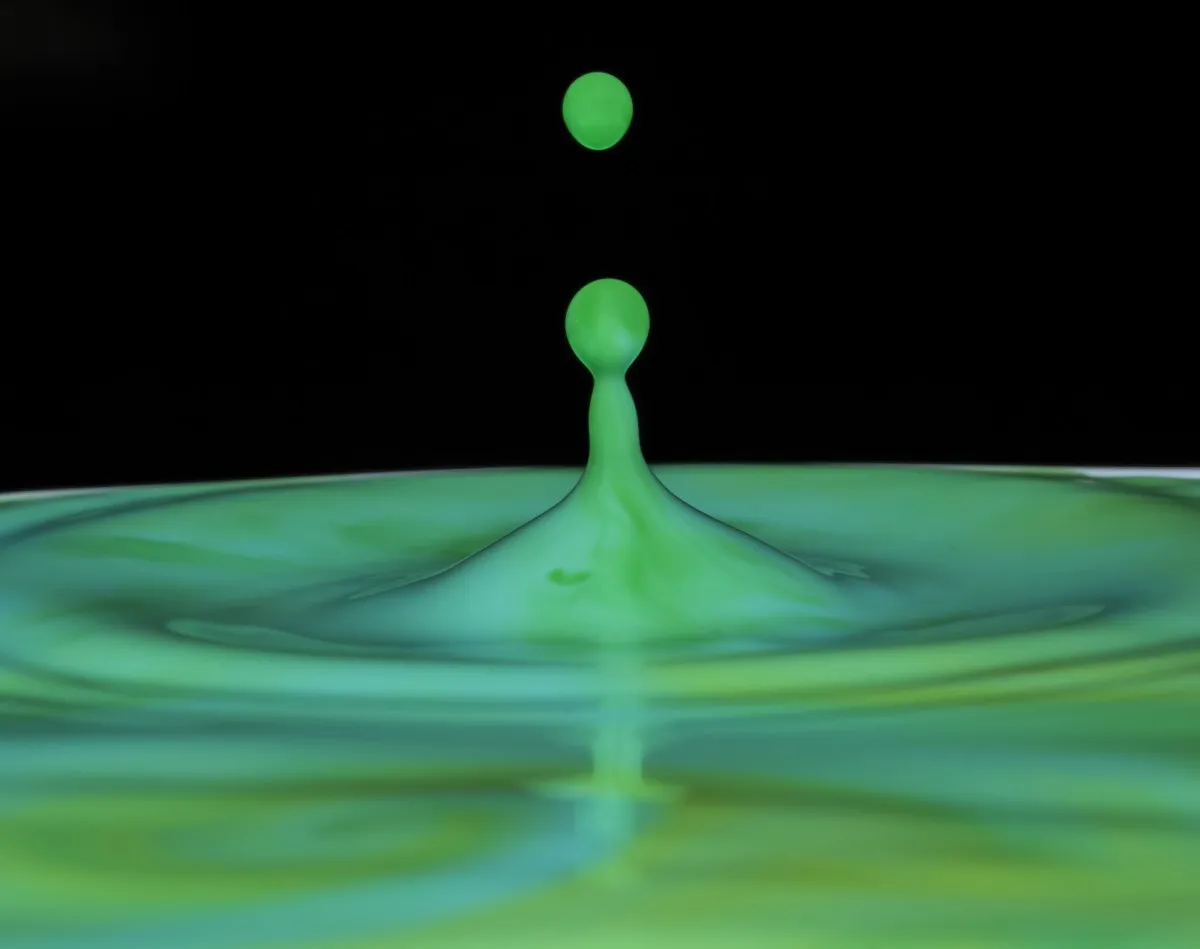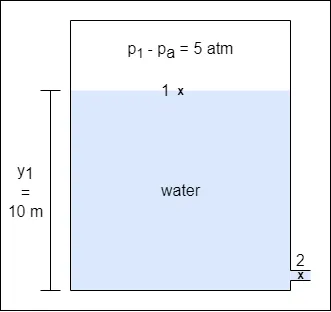
[Image1]
Introduction
Hey it's a me again @drifter1!
Today we continue with Physics, and more specifically the branch of "Classical Mechanics", in order to get into Exercises on Fluid Dynamics.
So, without further ado, let's get straight into it!
Volume Flow Rate Example
Consider a water pipe with varying radius that's filled completely with water. The volume flow rate is 0.8 m3 / sec. Supposing ideal fluid, calculate:
- the flow speed at a cross-section of radius 0.2 m, and
- the radius of the pipe at a section where the flow speed is 3 m / sec
The flow rate is constant throughout the pipe, and so for the first calculation, we simply have to solve Q = Av for the velocity v. The area of a circle is given by πr2 and thus the result is:

Similarly, for the second case, the missing quantity is now the area A:

And so, the radius is approximately:

Flow Continuity Example
Consider another water pipe with varying radius that's filled completely with ideal fluid. At some cross-section of area 0.1 m2 the flow speed is 2 m / sec. Let's calculate:
- the flow speed at cross-sections of 0.05 m2 and 0.15 m2 respectively, and
- the volume of fluid that flows through the pipe each hour
Let's skip the volume flow rate calculation, and directly calculate the missing flow speed from the flow continuity equation. As such, the flow speed at the two mentioned cross-sections is:

The volume that flows through the pipe during an hour, which equals 3600 sec, equals the volume flow rate times the duration, V = Qt. The volume flow rate can be calculated at any given cross-section because it remains constant. Choosing the initially given information, the volume that passes in an hour is:

Bernoulli’s Equation Example
Consider a closed fluid tank filled with water up to a height of 10 m, and air on top with a gauge pressure of 5 atm. Water flows out of a small cross-section of some cm at the bottom. What's the velocity of the water flowing out of that cross-section?
The density of water is 1 x 103 Kg / m3 and atmospheric pressure is 1 atm = 1.013 x 105 Pa.

The difference between the areas A1 and A2 is enormous, and so v1 << v2, allowing us to consider the smaller velocity v1 = 0.
In a similar manner, the height at which the water flows out of the cross-section the bottom is much less than the height h1, allowing us to consider y2 = 0.
As such, two terms of Bernoulli's Equation can be easily neglected:

The pressure at the second point equals the atmospheric pressure, p2 = pa, as it's open to the atmosphere. With that everything is known and what remains to be done is solving for v2.

Viscosity Example
Let's lastly also get into an example on real fluids...
Consider water of 20° C that flows through a pipe of 30 cm radius. The viscosity of water at the mentioned conditions is about 1 centipoise (1 cP = 0.01 P). If the velocity of the water at the center of the pipe is 3 m / s and the flow is laminar, calculate:
- the velocity 15 cm from the center and pipe walls (at a median distance),
- the velocity 1 cm from the pipe wall
- the pressure difference at a length of 1 m
The given velocity of 3 m / sec at the center is also the maximum velocity of the flow. As we move further and further from the center the velocity decreases, until it reaches 0 at the pipe walls.
More specifically, if R is the radius of the pipe and r the distance from the center, it can be proven that the velocity is given by the following equation:

As such, in the median distance, the velocity drops to:

Whilst, the velocity at a distance of 30 - 1 = 29 cm is:

Additionally, it can be proven as well that the average velocity of the flow is exactly half the maximum velocity, and so 1.5 m / sec in the case of this example.
The volume flow rate is equal to the area times that average velocity and so:

Now we can apply Poiseuille’s Law in order to determine the pressure difference:

RESOURCES:
Images
Mathematical equations used in this article, where made using quicklatex.
Visualizations were made using draw.io.
Previous articles of the series
Rectlinear motion
- Velocity and acceleration in a rectlinear motion -> velocity, acceleration and averages of those
- Rectlinear motion with constant acceleration and free falling -> const acceleration motion and free fall
- Rectlinear motion with variable acceleration and velocity relativity -> integrations to calculate pos and velocity, relative velocity
- Rectlinear motion exercises -> examples and tasks in rectlinear motion
Plane motion
- Position, velocity and acceleration vectors in a plane motion -> position, velocity and acceleration in plane motion
- Projectile motion as a plane motion -> missile/bullet motion as a plane motion
- Smooth Circular motion -> smooth circular motion theory
- Plane motion exercises -> examples and tasks in plane motions
Newton's laws and Applications
- Force and Newton's first law -> force, 1st law
- Mass and Newton's second law -> mass, 2nd law
- Newton's 3rd law and mass vs weight -> mass vs weight, 3rd law, friction
- Applying Newton's Laws -> free-body diagram, point equilibrium and 2nd law applications
- Contact forces and friction -> contact force, friction
- Dynamics of Circular motion -> circular motion dynamics, applications
- Object equilibrium and 2nd law application examples -> examples of object equilibrium and 2nd law applications
- Contact force and friction examples -> exercises in force and friction
- Circular dynamic and vertical circle motion examples -> exercises in circular dynamics
- Advanced Newton law examples -> advanced (more difficult) exercises
Work and Energy
- Work and Kinetic Energy -> Definition of Work, Work by a constant and variable Force, Work and Kinetic Energy, Power, Exercises
- Conservative and Non-Conservative Forces -> Conservation of Energy, Conservative and Non-Conservative Forces and Fields, Calculations and Exercises
- Potential and Mechanical Energy -> Gravitational and Elastic Potential Energy, Conservation of Mechanical Energy, Problem Solving Strategy & Tips
- Force and Potential Energy -> Force as Energy Derivative (1-dim) and Gradient (3-dim)
- Potential Energy Diagrams -> Energy Diagram Interpretation, Steps and Example
- Internal Energy and Work -> Internal Energy, Internal Work
Momentum and Impulse
- Conservation of Momentum -> Momentum, Conservation of Momentum
- Elastic and Inelastic Collisions -> Collision, Elastic Collision, Inelastic Collision
- Collision Examples -> Various Elastic and Inelastic Collision Examples
- Impulse -> Impulse with Example
- Motion of the Center of Mass -> Center of Mass, Motion analysis with examples
- Explaining the Physics behind Rocket Propulsion -> Required Background, Rocket Propulsion Analysis
Angular Motion
- Angular motion basics -> Angular position, velocity and acceleration
- Rotation with constant angular acceleration -> Constant angular acceleration, Example
- Rotational Kinetic Energy & Moment of Inertia -> Rotational kinetic energy, Moment of Inertia
- Parallel Axis Theorem -> Parallel axis theorem with example
- Torque and Angular Acceleration -> Torque, Relation to Angular Acceleration, Example
- Rotation about a moving axis (Rolling motion) -> Fixed and moving axis rotation
- Work and Power in Angular Motion -> Work, Work-Energy Theorem, Power
- Angular Momentum -> Angular Momentum and its conservation
- Explaining the Physics behind Mechanical Gyroscopes -> What they are, History, How they work (Precession, Mathematical Analysis) Difference to Accelerometers
- Exercises around Angular motion -> Angular motion examples
Equilibrium and Elasticity
- Rigid Body Equilibrium -> Equilibrium Conditions of Rigid Bodies, Center of Gravity, Solving Equilibrium Problems
- Force Couple System -> Force Couple System, Example
- Tensile Stress and Strain -> Tensile Stress, Tensile Strain, Young's Modulus, Poisson's Ratio
- Volumetric Stress and Strain -> Volumetric Stress, Volumetric Strain, Bulk's Modulus of Elasticity, Compressibility
- Cross-Sectional Stress and Strain -> Shear Stress, Shear Strain, Shear Modulus
- Elasticity and Plasticity of Common Materials -> Elasticity, Plasticity, Stress-Strain Diagram, Fracture, Common Materials
- Rigid Body Equilibrium Exercises -> Center of Gravity Calculation, Equilibrium Problems
- Exercises on Elasticity and Plasticity -> Young Modulus, Bulk Modulus and Shear Modulus Examples
Gravity
- Newton's Law of Gravitation -> Newton's Law of Gravity, Gravitational Constant G
- Weight: The Force of Gravity -> Weight, Gravitational Acceleration, Gravity on Earth and Planets of the Solar System
- Gravitational Fields -> Gravitational Field Mathematics and Visualization
- Gravitational Potential Energy -> Gravitational Potential Energy, Potential and Escape Velocity
- Exercises around Newtonian Gravity (part 1) -> Examples on the Universal Law of Gravitation
- Exercises around Newtonian Gravity (part2) -> Examples on Gravitational Fields and Potential Energy
- Explaining the Physics behind Satellite Motion -> The Circular Motion of Satellites
- Kepler's Laws of Planetary Motion -> Kepler's Story, Elliptical Orbits, Kepler's Laws
- Spherical Mass Distributions -> Spherical Mass Distribution, Gravity Outside and Within a Spherical Shell, Simple Examples
- Earth's Rotation and its Effect on Gravity -> Gravity on Earth, Apparent Weight
- Black Holes and Schwarzschild Radius -> Black Holes (Creation, Types, How To "See" Them), Schwarzschild Radius
Periodic Motion
- Periodic Motion Fundamentals -> Fundamentals (Period, Frequency, Angular Frequency, Return Force, Acceleration, Velocity, Amplitude), Simple Harmonic Motion, Example
- Energy in Simple Harmonic Motion -> Forms of Energy in SHM (Potential, Kinetic, Total and Maximum Energy, Maximum Velocity), Simple Example
- Simple Harmonic Motion Equations -> SHM Equations (Displacement, Velocity, Acceleration, Phase Angle, Amplitude)
- Simple Harmonic Motion and Reference Circle -> SHM and Smooth Circular Motion, Reference Circle
- Simple Harmonic Motion Exercises -> 2 Complete Examples on Simple Harmonic Motion
- Simple Pendulum -> Simple Pendulum (Return Force, Small Angle Approximations, More Accurate Period, Gravity Approximation)
- Physical Pendulum -> Physical Pendulum (Return Torque, Small Angle Approximations, Estimating Moment of Inertia)
- Exercises around Pendulums -> Complete Examples on the 2 types of Pendulums (Simple, Physical)
- Damped Oscillation -> Damping Force, Total Force and Differential Equation, Motion Equations, Special Cases
- Forced Oscillation and Resonance -> Forced Oscillation (Differential Equation, Amplitude, Resonance)
- Exercises around Damped and Forced Oscillation -> Complete Examples on Damped Oscillation and Forced Oscillation
- Chaos and Chaotic Oscillation -> Chaos, Unpredictability and Randomness, Chaotic Oscillation
Fluid Mechanics
- Density and Pressure -> Fluids and Fluid Mechanics, Density, Specific Gravity, Pressure
- Measuring Pressure in Fluids -> Pressure in Fluids (Variation with Depth), Absolute and Gauge Pressure, Measuring Pressure
- Pascal's Principle and Hydraulics -> Static Equilibrium, Pascal's Principle, Hydraulic Systems
- Archimedes' Principle and Buoyancy -> Buoyant Force, Archimedes' Principle, Relation with Density
- Surface Tension -> Surface Tension (Cohesive and Adhesive Forces, Unit, Definition), Capillarity
- Exercises on Fluid Statics (part 1) -> Various Density and Pressure Examples
- Exercises on Fluid Statics (part 2) -> Hydraulic Car Jack, Buoyancy Examples, Surface Tension Example
- Introduction to Fluid Dynamics -> Ideal Fluid, Flow Characteristics, Volume Flow Rate, Flow Continuity, Mass Flow Rate
- Bernoulli’s Equation -> Energy Conservation and Flow, Bernoulli's Equation and Principle
- Viscosity and Turbulence -> Real Fluid, Viscosity, Measuring Viscosity, Poiseuille’s Law, Stokes' Law, Turbulence and Reynolds number
Final words | Next up
And this is actually it for today's post!
After a small break period, where I will get back to other series of the blog, we will start with a new chapter of Mechanics : "Waves".
See ya!

Keep on drifting!